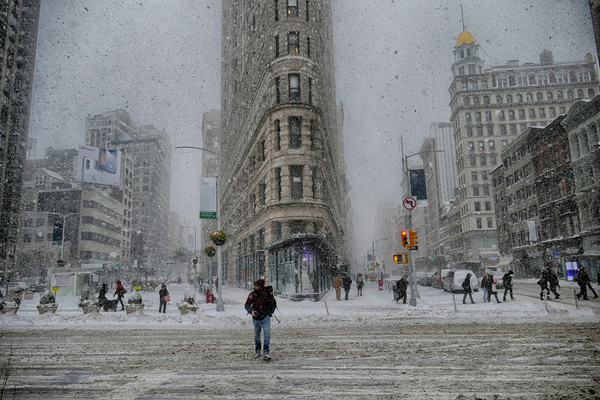A “bomb cyclone” hit the Eastern U.S. over the weekend, and it left a lot of weather nerds scrambling to enter “what causes a Bomb Cyclone” into their search engines. This weather nerd is one of them. To put it simply, a bomb cyclone, which occurs through the process known as bombogenesis, is basically a winter hurricane. It “occurs when a mid-latitude cyclone rapidly intensifies,” or quickly drops in atmospheric pressure, marking the strengthening of the storm, according to the National Oceanic and Atmospheric Administration (NOAA).
According to The Weather Channel, bombogenesis itself is an ominous-sounding term frequently used in the winter to describe powerful low-pressure systems that intensify rapidly. The process of bombogenesis begins as cyclogenesis, meaning the development or strengthening of an area of low pressure. To be classified as a weather bomb, or having undergone bombogenesis or “bombing out,” the central pressure of a low-pressure system must drop at least 24 millibars within 24 hours.
A 2021 study lead by Robert Fritzen from Northern Illinois University found that only about 7 percent of all non-tropical low pressure systems near North America from 1979-2019 were bomb cyclones. The large majority of those occurred off the East Coast of the U.S., which averaged one such bomb cyclone per year.
In the case of the recent storms going up the East coast, bombogenesis results when there is a large temperature gradient, usually between a cold continental air mass and warm sea-surface temperatures in the Atlantic. However, it can also be the product of a cold polar air mass and much warmer air from the south, say, over the Plains state. Over that temperature contrast, a powerful, intensifying jet-stream disturbance triggers air to rise, kicking off the bombogenesis process. This happens most often from October through March, but it can happen any time of year. Frequently, nor’easters are weather bombs due to cold air surging southward from Canada combined with the warm ocean waters of the Gulf Stream.
So, what happens when a weather bomb strengthens? Winds increase dramatically, and precipitation, including snowfall, can become intense. Blizzard conditions can occur, sometimes accompanied by lightning as the system is “bombing out.”
The corridor off the East Coast of the U.S. is notorious for bombogenesis events, particularly in recent years. Here are some recent, notable examples, courtesy weather.com:
- In early-March 2018, the first of the so-called four-easters, Winter Storm Riley, bombed out off the East Coast and drove destructive coastal flooding into parts of the Eastern Seaboard.
- Two months prior to that in early-January 2018, Winter Storm Grayson intensified at the most rapid rate on record for the western Atlantic Ocean, plunging roughly 59 millibars in 24 hours to a low of 950 millibars.
- Winter Storm Mars underwent bombogenesis in February 2016. The central pressure of this system dropped from 1,004 millibars at 7 a.m. EST Feb. 7 to 979 millibars by 1 a.m. EST Feb. 8, or 25 millibars in only 18 hours. Blizzard conditions were verified in multiple locations on Cape Cod, and a wind gust of 65 mph was measured on Nantucket Island.
- In 2015, Winter Storm Iola exhibited bombogenesis when its pressure dropped from 1,009 millibars to 980 millibars from 7 p.m. Jan. 23 through 4 p.m. Jan. 24 – a drop of 29 millibars in 21 hours. Strong winds from Iola caused coastal flooding at some locations in Massachusetts.
- This also happened in February 2013, when Winter Storm Nemo dropped 29 millibars within a span of 24 hours (specifically, a barometric pressure of 1,000 millibars was recorded at 4 a.m. on Feb. 8, and it dropped to 971 millibars at 4 a.m. on Feb. 9).
Mars, Iola and Nemo all brought snow to areas of the Northeast, but even though weather bombs typically are found during the winter with a marine influence, this is not always the case. An example of bombogenesis over land was the “Octobomb” that impacted portions of the Plains and Midwest Oct. 25-27, 2010. All-time record-low barometric pressure readings were set by this system in Minnesota and Wisconsin.
—
Photo Credit: David Reilly / Shutterstock.com
